I don’t normally deal in reviews of new products as I generally leave that up to one of the many other excellent bloggers out there, but for this, my review of the new DOOMO Meter S, I decided to give it a shot.
Although Sunny 16 and my simplified Outdoor Eight rules have served me well over the years for the various camera reviews I’ve written, I’ll admit that there were a variety of times where I didn’t quite get it right. These instances usually involved indoor scenes or when I took on too many variables of poor outdoor lighting, expired film, or unreliable shutters.
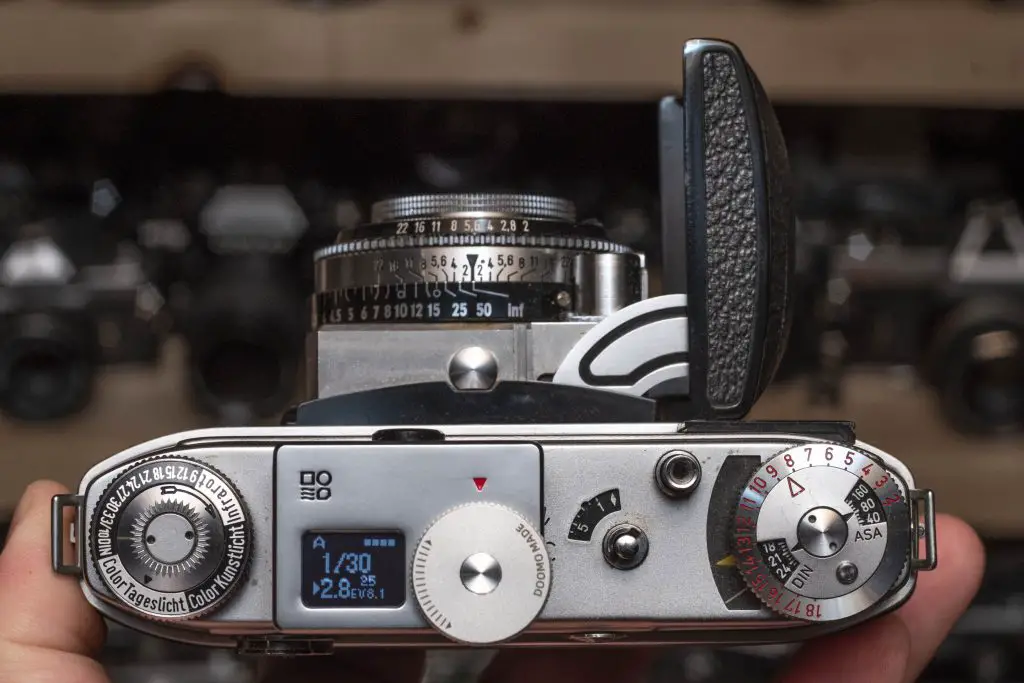 Sure, I have a literal box full of hand held Weston, GE, and Sekonic meters that I could use, but I’m lazy and don’t want to have to lug around any additional equipment, so I knew if I was going to add a meter to my shooting regimen, it had to be one of the clip-on types.
Sure, I have a literal box full of hand held Weston, GE, and Sekonic meters that I could use, but I’m lazy and don’t want to have to lug around any additional equipment, so I knew if I was going to add a meter to my shooting regimen, it had to be one of the clip-on types.
There are a lot of great options out there today. I’ve read reviews for clip-on meters from Reveni Labs, Hedeco, and various other Chinese made meters available for sale on eBay. On more than one occasion, I almost bought one, but I found that of the currently available models, none met all of my criteria, which was to be compact, good looking, and have some type of LCD screen. Sure, meters exist with some of these criteria, but none close enough to what I was picturing in my head. That was until I saw the recently released DOOMO Meter S.
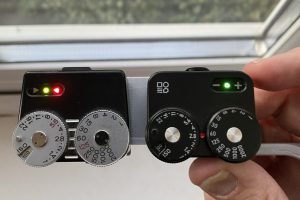
If the name DOOMO sounds familiar, it’s because they already have a pretty neat light meter called the DOOMO Meter D, which is an updated copy of the classic Voigtländer VCII Meter. It was a proven design that looked great mounted on top of a classic rangefinder, but it didn’t have an LCD screen, or another feature I didn’t realize I wanted until I saw the DOOMO Meter S, which was what DOOMO calls “One Time Metering”.
At a retail price of just under $100 USD, the DOOMO Meter S is already less expensive than most other options out there, including those from DOOMO. As of this writing, DOOMO doesn’t have a US distributor, so the only way to buy it is either direct from China through the company, or direct from China through a Chinese distributor on eBay. I found that the eBay sellers were a couple bucks cheaper, so I went that route.
It would take about two and a half weeks for the meter to arrive, and when it did, I quickly tore into the padded envelope it traveled half the world in.
My Thoughts
The DOOMO Meter S arrived in a small black box. A white sticker affixed to the side and the back wraps around one of the box’s seams and on mine was already cut open. I am unsure if I was given a used copy, or if this happened at customs somewhere, but everything appeared to be new in the box and nothing was missing.
I had intended on making an unboxing video, but I couldn’t get the lighting right in the video, so instead here is a gallery of still photos I took of the unboxing process.
The packing materials feel high quality, with the meter enclosed in a small white plastic bag, surrounded by a black piece of rubber foam, with a sticker in the bottom left corner, telling you to that there are accessories beneath it.
Lift up the foam (they call it a sponge) and there is a small bag with the removable accessory shoe and 4 screws. Outside of the bag is a short USB-C charging cable, a small screwdriver and a quick reference guide that explains the camera’s basic operation. A QR code on this card can be scanned with your phone, which will take you to a Chinese website that my computer’s firewall had an issue with. I navigated to it inside of a sandbox and it took me to a single JPG of instructions only barely more descriptive than the quick reference card.
The look and feel of the meter itself is excellent. On my kitchen scale with the accessory clip attached, it weighs 38 grams which means you’re not likely to feel the additional weight when mounted to most cameras.
I purchased the chrome version and found the chrome to look and feel high quality. According to the guide on the Chinese website, the body is made of zinc and aluminum alloy. If there is plastic in this thing, it’s not obvious from the outside.
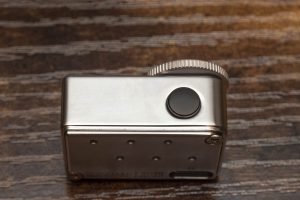
The control wheel is labeled only with arrows and the words “Doomo Made”. It rotates freely, without click stops, in both directions very smoothly with just enough resistance to feel like something’s happening, but without being difficult.
Around back is a single black button which along with the wheel are the only two control points for the meter.
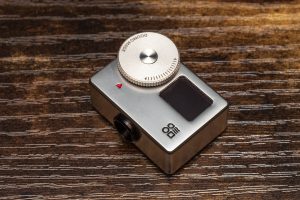
Up front is the opening for the exposure meter. According to the documentation, the meter takes an average reading with an angle of view of 30 degrees. Nowhere in the documentation does it say what kind of meter it is. I am sure it’s some kind of modern silicon based meter as it’s response time seems much faster than Cadmium Sulfide (CdS) meters of the past.
Flip the meter over and the bottom has six screw holes, which are used in pairs to mount the accessory shoe into a left, center, and right position.
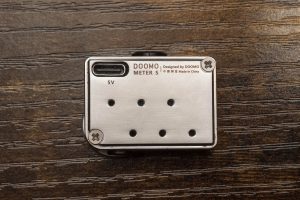
Finally, in the upper left corner is the USB-C charging port for the built-in rechargeable 120mAh Lithium battery. Apparently, the earlier DOOMO Meter D uses a removable and non-rechargeable CR1632 battery that must be purchased separately from the meter, so the inclusion of a rechargeable battery seems like a nice upgrade.
According to the Chinese website, the 120 mAh lithium battery takes about an hour and a half to fully charge, at which point it will last for 12 hours non stop. Of course, I don’t think anyone would ever need to continuously meter something for 12 straight hours, so the amount of time the meter would last with intermittent use is likely much longer. I’ve had this meter for a couple weeks already and have not had to recharge it once, suggesting a pretty good life span.
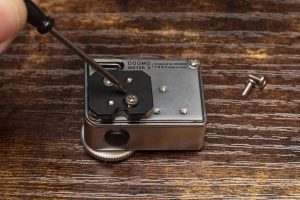
Deciding which of the three positions for the accessory shoe is usually decided by which camera you mount it on as depending on the model, the meter can interfere with top plate controls. Using it on a Canon IV Sb, which is like most screw mount Leica and Leica clones, works best with the shoe on the right. On a Retina IIIC, it worked best with it on the left, and on most SLRs and the Contax II, it worked best in the center.
Changing screws is simple to do with either the included, or any precision Philips screw driver. The Chinese website cautions you from using screws other than the ones included, as longer screws may extend too far into the meter and damage the battery or electronics. Although four screws are included, you only need two to mount is, so consider the other two as spares.
The first time you use the DOOMO Meter S, it is not completely obvious how it works, but the quick reference card tells you everything you need to know. The learning curve is very short as you’ll get the hang of it really quickly.
A single press of the rear button turns the meter on. Once the LCD lights up, the screen will remain illuminated for 20 seconds after the last thing you do with the meter. After the 20 second screen time out, the meter is still on, and it remembers whatever settings or reading you last took. It will remain in this “screen off/power on” state for 3 minutes, at which time, the entire meter shuts down and you’ll lose your last reading. A quick press of the back button will resume normal operation, or power it back on, if it is completely off.
The first thing you’ll want to do before using the meter is to set the ISO speed to match film you are using. The DOOMO Meter S supports a wide range of film speeds from ISO 8 to 6400. To set the ISO, press and hold the rear button for about 5 seconds, or until the ISO number begins to flash. Once the number is flashing, rotate the control wheel until your chosen speed is selected and then single press the rear button to save your setting.
With the correct ISO selected, you must decide which of the two metering modes you want to use, A (aperture priority) or T (shutter priority). These work about how you’d expect them on any auto exposure camera with either mode. You cycle back and forth between the two modes by double pressing the back button.
Set the DOOMO Meter S to A mode and using the wheel, you can select a range of f/stops from f/1 to f/32 and the meter will make a recommended shutter speed based on available light. Set the meter to T mode and using the wheel, you can select a range of shutter speeds from 30 seconds to 1/8000 and the meter will make a recommended f/stop.
Shutter speeds follow the standard sequence of full stops found on most cameras made from the mid 1950s and on. The full selection is:
30, 15, 8, 4, 2, 1, 1/2, 1/4, 1/8, 1/15, 1/30, 1/60, 1/125, 1/250, 1/500, 1/1000, 1/2000, 1/4000, and 1/8000
Strangely however, the available f/stops increment in (mostly) half stops from:
f/1, f/1.2, f/1.4, f/1.7, f/2, f/2.6, f/2.8, f/3.5, f/4, f/4.5, f/5.6, f/6.7, f/8, f/9.5, f/11, f/13, f/16, f/19, f/22, f/32
While these available options generally cover most commonly found vintage lenses, there are selections like f/2.6, f/6,7, and f/19 you won’t find on any lens.
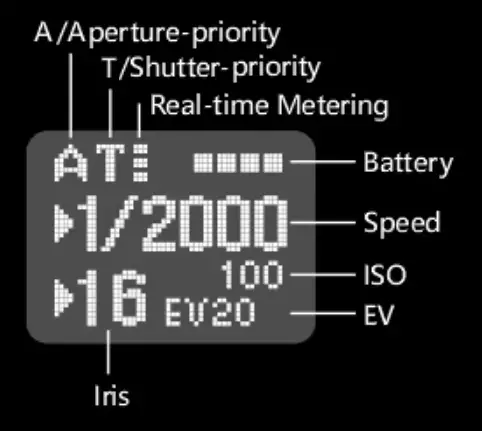
In use, this isn’t a huge deal, but this means the meter could potentially offer you a recommendation on an f/stop you can’t actually select, so for me, I found that using the camera in A mode was more logical, as I could set whatever f/stop I wanted, and the meter would be limited to only shutter speeds I could actually use.
One small, but really cool feature that I appreciated is the EV display, which would come in useful for mid century film cameras that have EV scales on the shutter. These kinds of cameras were popular before coupled exposure meters were common, allowing the photographer to take an EV reading with their meter, and then transfer that to their camera, without having to worry about shutter speeds or f/stops.
Finally, the last setting for the DOOMO Meter S is whether you want to use it in real-time (continuous) metering or instant metering modes. This is done by long pressing the back button for 2 seconds to toggle between the two modes. With the meter in continuous metering mode, an icon with three small squares will appear to the right of the A or T mode indicator. Without the three small squares, the meter is in instant metering modes, which only takes a single reading when pressing the rear button.
The option for both modes is another upgrade from the DOOMO Meter D which only has a continuous metering mode. Within minutes of trying out the DOOMO Meter S, I quickly preferred the instant metering mode as I found that I get different meter readings with the camera to my face when I am looking through the viewfinder as when I have to lower the meter to my chest so I can read it. In instant mode, a quick press of the button with the camera to your eye will capture a reading and save it, so you can then lower the meter to read it. This, at least in theory, means you are getting an accurate reading with the camera in shooting position. Although there are pros to having a continuous metering mode too, the option to use both seems to be a huge upgrade over the DOOMO Meter D in my opinion.
And that’s it. The entire operation of the DOOMO Meter S is to turn it on, select a film speed, choose either A or T metering modes, and whether you want continuous or instant meter readings.
Gallery
While logic says that it shouldn’t matter what a product looks like as long as it does what it’s supposed to, that doesn’t stop us from pining for a good looking classic camera or automobile based solely on it’s looks. How the DOOMO Meter S looked while mounted to a camera was important to me, so here is a gallery of the meter mounted to a variety of cameras I’d be likely to use it on.
The DOOMO Meter S comes in both chrome and black, but I only have the chrome one, so I’ll only show what it looks like on chrome bodied cameras.
The DOOMO Meter S can be used hand held or mounted to the accessory shoe on top of most cameras. I say “most” cameras because not every accessory shoe is the same. Some are made from a thicker gauge metal, some thinner and I found that how the meter fit on some cameras was not consistent.
In the gallery above, the meter fits snugly on the Canon IV Sb, the Leica M3, and the Minolta Autocord. On the Retina, the shoe is made from a thinner gauge metal and when I slid the meter onto it, it was very loose. The Argus C3 Match-Matic is even worse as the meter flops back and forth in the shoe and falls off very easily. I would not feel comfortable walking around with the DOOMO mounted to the C3 for fear of me losing it.
Edit: After publishing this review, I noticed that if I rotated the accessory clip 180 degrees and mounted it backwards from how I had it before, it fit much better on both the Retina and the Argus. The instructions call this “inversion”, which suggests they accounted for this in the design. I am retaining my original text, since if I missed it, you might too.
In the case of the Contax II and a Kiev IV (not shown), the meter is on so tight, that I was concerned I might actually break the meter’s clip when taking it off the camera. I also tried mounting the meter on a Perfex Forty-Four and Clarus MS-35 and it wouldn’t go on at all.
On DOOMO’s website for the Meter S, they also sell custom cut 3M adhesive pads for mounting it into cameras without a shoe, or with a shoe that doesn’t work. Although I did not buy these pads, they look like the same 3M pads you can buy at the hardware store and cut yourself.
Accuracy
No matter how cool a meter looks, or how easy it is to use, or how cheap it is, it’s not worth a damn if it can’t give accurate readings, so the most important attribute I can discuss here is it’s accuracy.
Having never written a review about an exposure meter before, I figured I wouldn’t over think the process. My goal was to take the meter out into a couple of different real world shooting situations and compare it to a known accurate exposure meter. For that, I chose my Fuji X-T20 mirrorless camera. This is my primary digital camera, and the one I use to take the majority of photos for this site on. Although first released in 2017, it has as advanced of a metering circuit as any new camera sold today, so I thought it would be good enough for this.
My process was to set both the meter and the camera to a consistent ISO and compare the meter’s recommendations in both A mode (aperture priority) and T mode (shutter priority), setting the camera in each corresponding mode to see how close the two were. The DOOMO Meter S is not capable of full programmed readings, so I did each test twice.
Note: In the images below which show the LCD screen on the DOOMO Meter S, you’ll notice that in many of the images, especially the ones in bright sunlight, part of the LCD screen disappears. This is a result of the refresh rate on the LCD being slower than my camera which causes parts of the screen to appear as if they are not there. You cannot see this in real life. Only in these images does it look like this, so this should not be seen as a defect in the meter.
For the first test, I did a simple mirror selfie. This is a shot I try to include in as many camera reviews as possible so I am familiar with how much light my vanity mirror produces. I know from experience that when using ISO 100 speed film, a shutter speed of 1/30 and f/4 is good enough to capture a properly exposed image. Since my Fuji digital mirrorless does not have an ISO setting for 100, I did this test with everything set at ISO 200.
Interestingly, the Fuji chose the exact same combination of 1/30 and f/4 that I always use for ISO 100 film, possibly suggesting that I could benefit from one additional stop of light when I do my mirror selfies.
The DOOMO Meter S was off by one full stop from what my camera recommended, choosing 1/60 and f/4 in A mode, and 1/30 and f/5.6 in T mode.
For my next shot, I took the camera outside in full shade and photographed the patio where I normally capture beauty shots for most reviews I write. If you look closely, the retaining walls and bushes in this image are seen in many of the backgrounds of cameras featured on this site. As with the mirror selfie pic, everything is still set to ISO 200.
The Fuji picked a shutter speed of 1/100 and f/5.6 for the above shot and the meter chose a very similar 1/125 and f/5.6 in A mode and half a stop slower 1/125 and f/6.7 in T mode.
Both of these readings are within one stop of the camera’s reading, and since 1/100 isn’t an option for the DOOMO Meter S, 1/125 is close enough to make barely any difference in the exposed image. The discrepancy of f/5.6 and f/6.7 between A and T mode could very easily be explained by reflections off the glass windows. Since the DOOMO Meter S uses an average reading, any difference in where I held the meter could account for that. Whatever the reason though, both readings are close enough to the digital camera that I’d just say they are spot on.
For the third test, I took the camera out in bright sunlight. The sun is behind me at a slight angle to my left. The sky was completely clear, but since I did this in December when the sun is at a much lower angle, my Sunny 16 instincts would have been to shoot this at f/11.
Whaddya know?! The Fuji X-T20 chose a shutter speed of 1/350 and f/11 for this image. In A mode the DOOMO Meter S went with 1/500 and f/11 and in T mode, 1/250 and f/13 (it is hard to read because of the refresh rate issue I explained earlier).
Once again, the DOOMO Meter S’s difference is negligibly slower. I think the math of 1/350 compared to 1/500 is about half a stop slower. In T mode, a slightly faster 1/250 shutter speed and slightly slower f/13 is effectively identical to the Fuji’s reading.
For the first three tests, I had the meter set to ISO 200, so I wanted to try a faster speed to mimic Fuji Superia 800 so I set both my camera and meter to ISO 800 and took another shot in identical light to the previous test. The only difference is I was a bit closer to the tree, showing a bit more shadow, and the sun was directly behind me now.
My digital camera baseline was 1/1250 and f/11, compared to the DOOMO Meter S which recommended 1/1000 and f/11 in A mode, and 1/1000 and f/13 in T mode. It is interesting that in both cases with T mode, the meter went with f/13 which is barely half a stop slower than f/11 which the camera went with. Once again, we’re talking about differences of less than a stop in both cases.
For the fifth test, I took a photo of myself reflected off a glass door. I am standing in heavy shade and the bright skyline is behind me giving a very strong backlight similar to if someone was standing indoors in front of an exterior window. This type of exposure scene is very difficult for most meters as getting that right balance of correct exposure on the much darker front subject and bright background is difficult.
As with the previous test, I kept both the camera and meter at ISO 800 and the Fuji chose 1/75 and f/8. The DOOMO Meter S was surprisingly very similar at 1/60 and f/8 in A mode and 1/60 and f/9.5 in T mode.
In my final test, I took a photo of my fully restored Pioneer SX-750 receiver illuminated with 2700K LED lighting. I raised the ISO to 1600 which is the fastest film I’ve personally ever shot. I figured if there was going to be one situation where the DOOMO Meter S struggled the most, this would be it.
The Fuji selected an odd ball 1/27 shutter speed and f/2.8 which is wide open for the kit lens I had and the meter chose a shutter speed of 1/30 with it set to f/2.8 in A mode and 1/30 and f/3.5 in T mode. Once again, the meter was about half a stop slow in shutter priority mode which I saw in earlier tests. While half a stop is hardly a huge amount, I find it interesting that this is consistently seen only in this mode
I had wanted to do more lighting situations, but found that between each of these 6 tests, the DOOMO Meter S was accurate enough that I am not certain doing more would produce wildly different results. In every case, the meter was within 1 stop or less from what my Fuji X-T20 chose which is going to be well within the latitude of nearly every film save maybe some slide films. In the instances where it was off, the meter seems to prefer underexpose than overexposure. If you’re shooting black and white or color films like Kodak Portra, you are not likely to notice these differences.
My Conclusions
The DOOMO Meter S is a really cool gadget and one that offers much more features than other, more expensive meters. Compared to the DOOMO Meter D which I read this excellent review for on 35mmc before purchasing the DOOMO Meter S, I noticed that the older model lacks a rechargeable battery, only supports continuous metering, and has only two locations for the accessory clip instead of three. Each of these are worthwhile upgrades that even without the LCD screen, would make it a more compelling option over the earlier model.
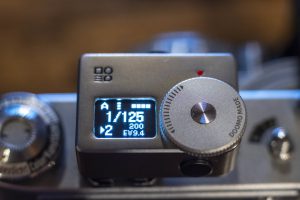
The build quality feels good, the LCD screen has all the info I need including EV numbers, is easy to read in all but in direct sunlight, the user interface, although not obvious without a quick look at the manual, is really easy to learn and once you get the hang of it, and the accuracy of the meter is good. (Here comes the but…)
But, whether you should ultimately run out and buy one for yourself depends greatly on what your expectations are for it. Clipping this thing onto the top of your Leica M3 or Kodak Retina is not going to instantly give it exposure accuracy and flexibility to the level of a modern digital camera.
The DOOMO Meter S takes an average reading which will not do well with strongly back or front lit scenes. It would not be ideal in situations where a spot meter is necessary, and like any hand held uncoupled meter, is not going to be very helpful in fast action scenes with rapidly changing amounts of light. For anyone with experience with hand held meters, none of what I’m saying here should be a surprise, but if you are a “meter novice” you really need to understand the limitations of a device like this. Simply mounting it to the accessory shoe of your Nikon SP rangefinder and completely trusting everything it tells you will likely produce unsatisfactory results.
Difficult lighting situations are going to throw off the DOOMO Meter S, and it does seem to prefer underexposure which is less desirable for most film stocks than overexposure. While the amount of error I found is hardly anything to balk at, I do wish that DOOMO had added some kind of calibration or manual +/- exposure setting to where you could set an intentional amount of exposure correction for this, but beyond that, I was very impressed with how accurate it was in most instances, even in my mirror selfie test. I feel confident that for a $100 meter, the DOOMO Meter S is going to be good enough for most people. If you are a professional photographer needing critical exposure on slide film or large formats, then you are definitely going to want to spend a little more money on something more suited to your needs.
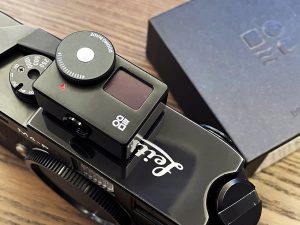
I started out this article by saying this is my first experience with a clip on meter. I cannot say with absolute certainty whether or not there are better options out there, but for less than $100, the DOOMO Meter S is an impressive device and one that I am very happy with.
The LCD screen and control wheel are very useful, the attractive metal body is much more appealing to me than the rough 3D printed Reveni Labs meter, having both instant and continuous metering modes is very useful, and having a built in rechargeable battery is a nice touch too. I don’t have any major, or even minor cons to this meter. If I had to come up with one minor suggestion for whatever DOOMO does next, would be to perhaps relocate the back button to the top plate, possibly even in the center of the wheel. I feel as though this would make it within easier reach of my right index finger, as opposed to the back of the meter which I tend to use my thumb to press.
But seriously, that’s it. This is a wonderful device, that for the price it sells for, I have no problem recommending it to anyone who shoots film today. Although I currently have the chrome version, it is cheap enough that I’ll likely buy a black one for use on my black cameras!

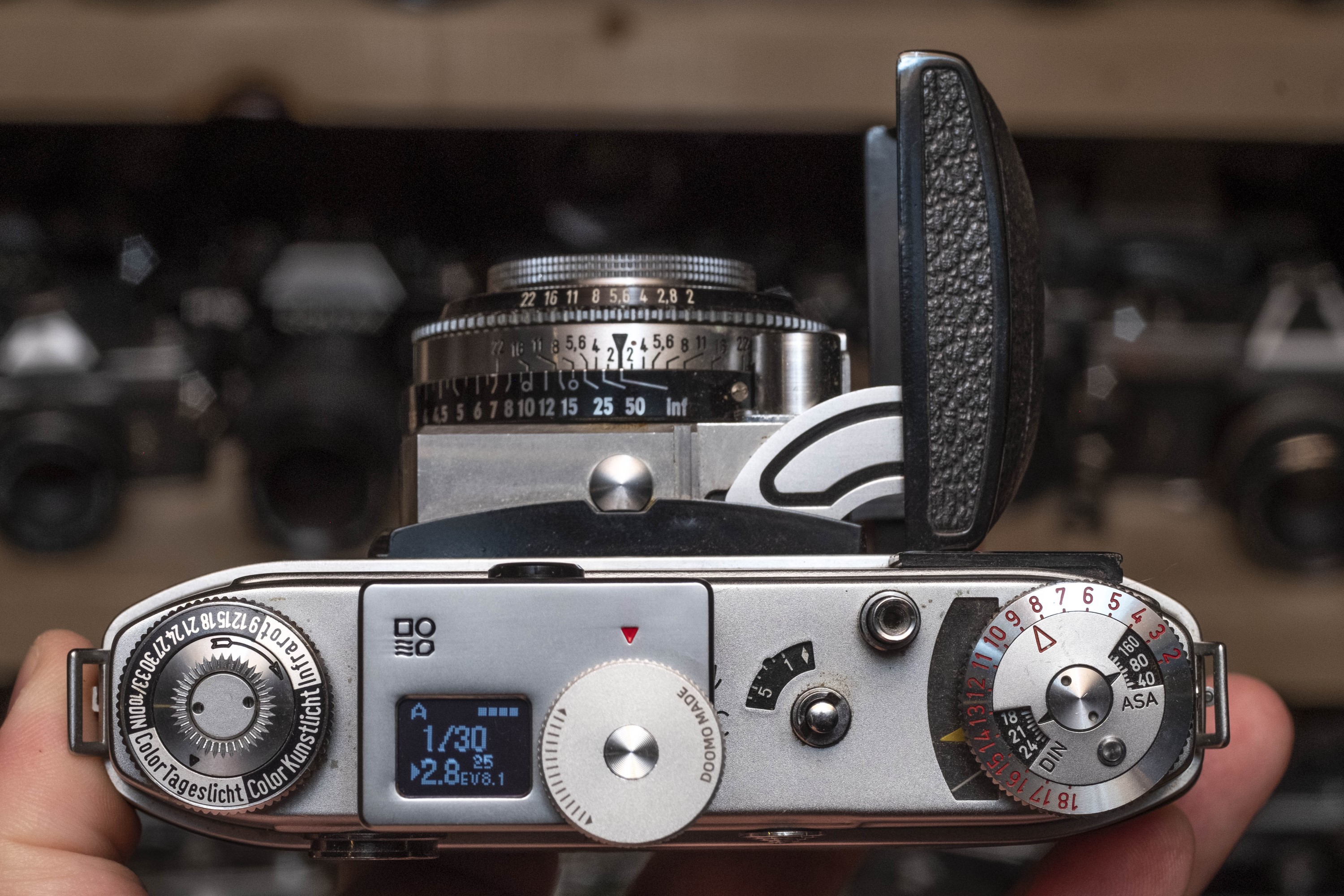
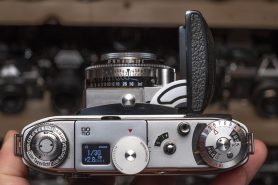
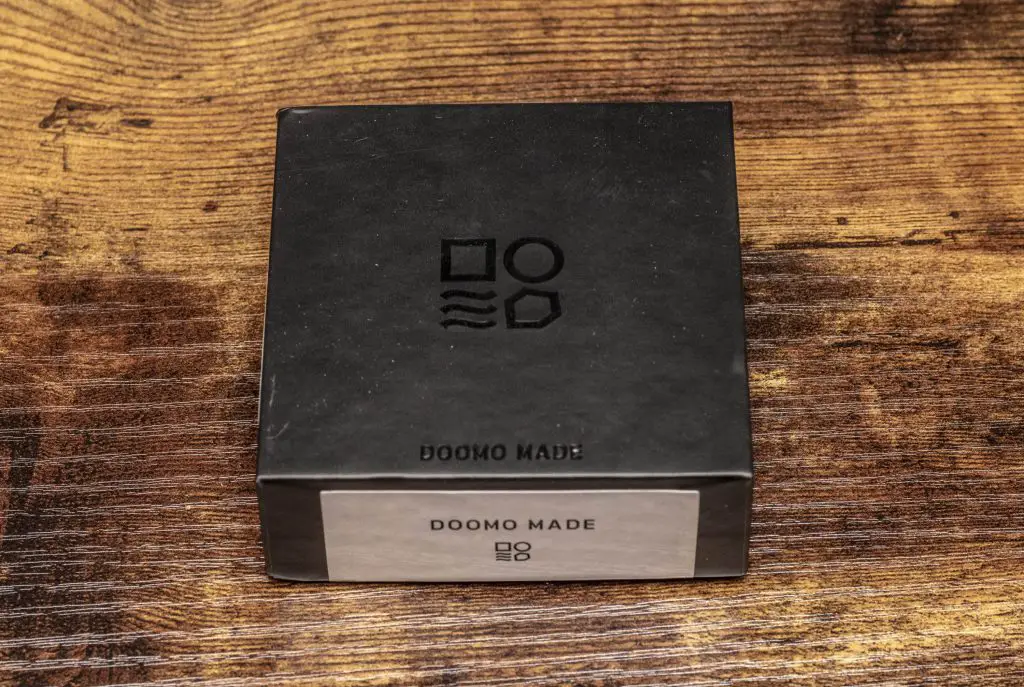
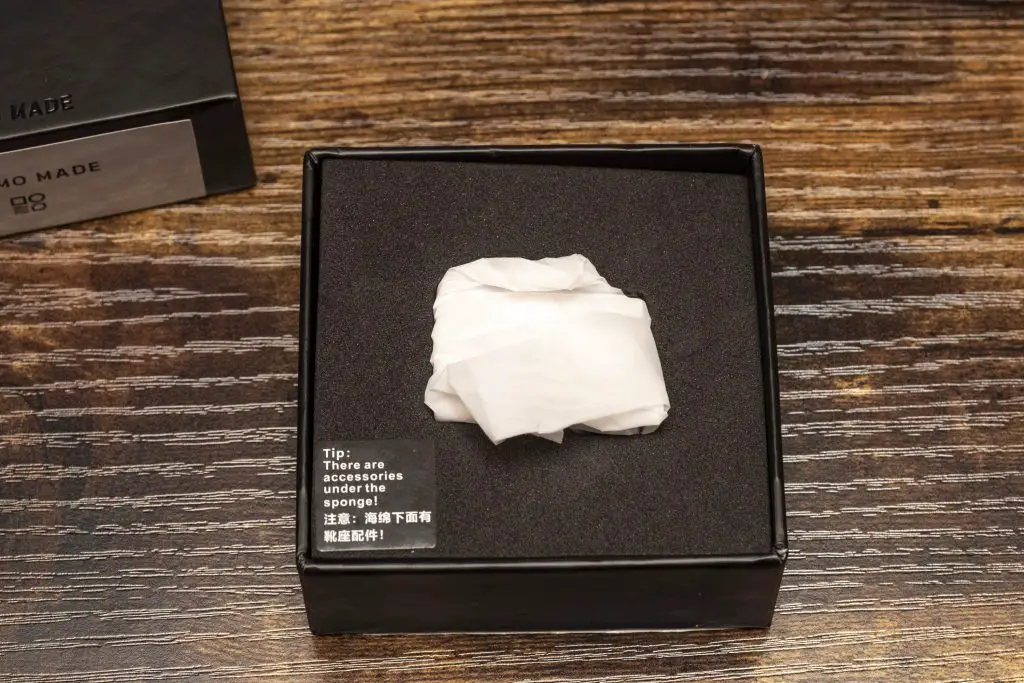
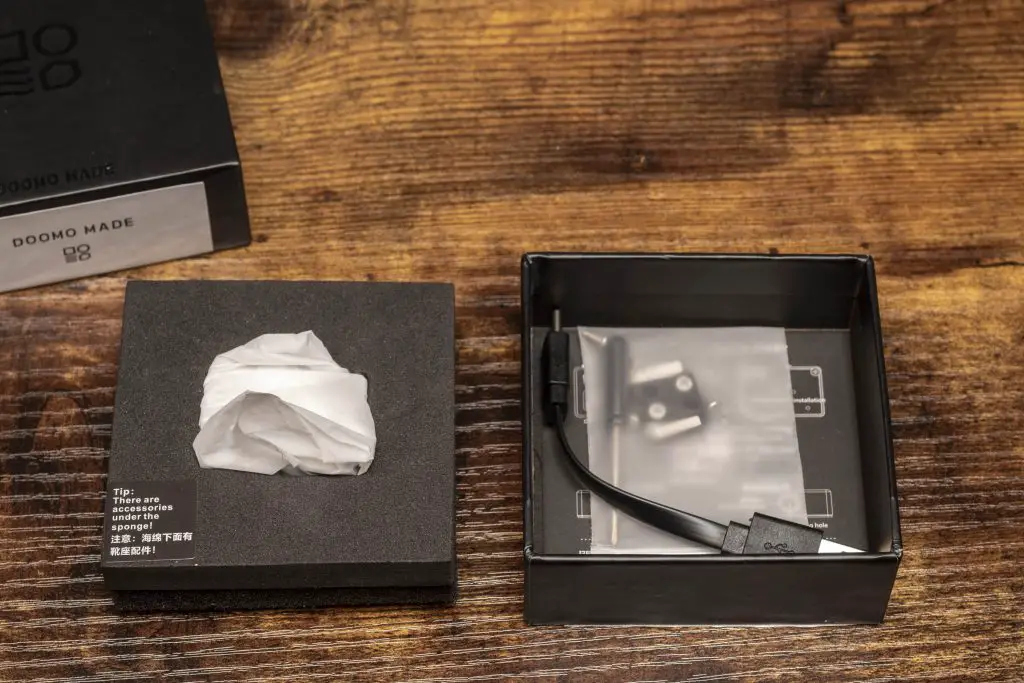
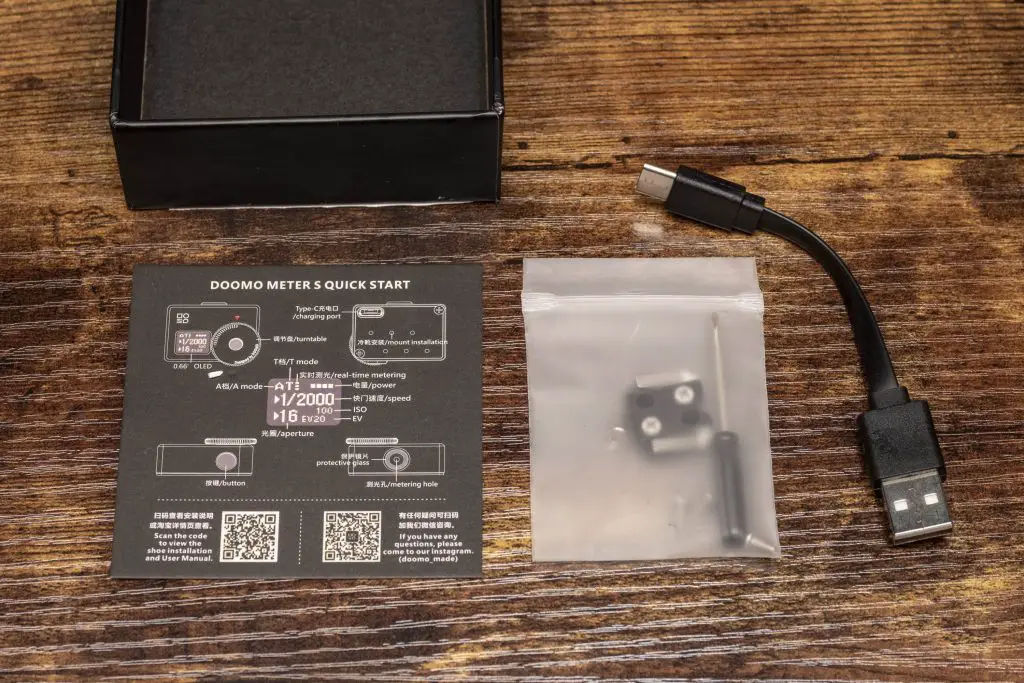


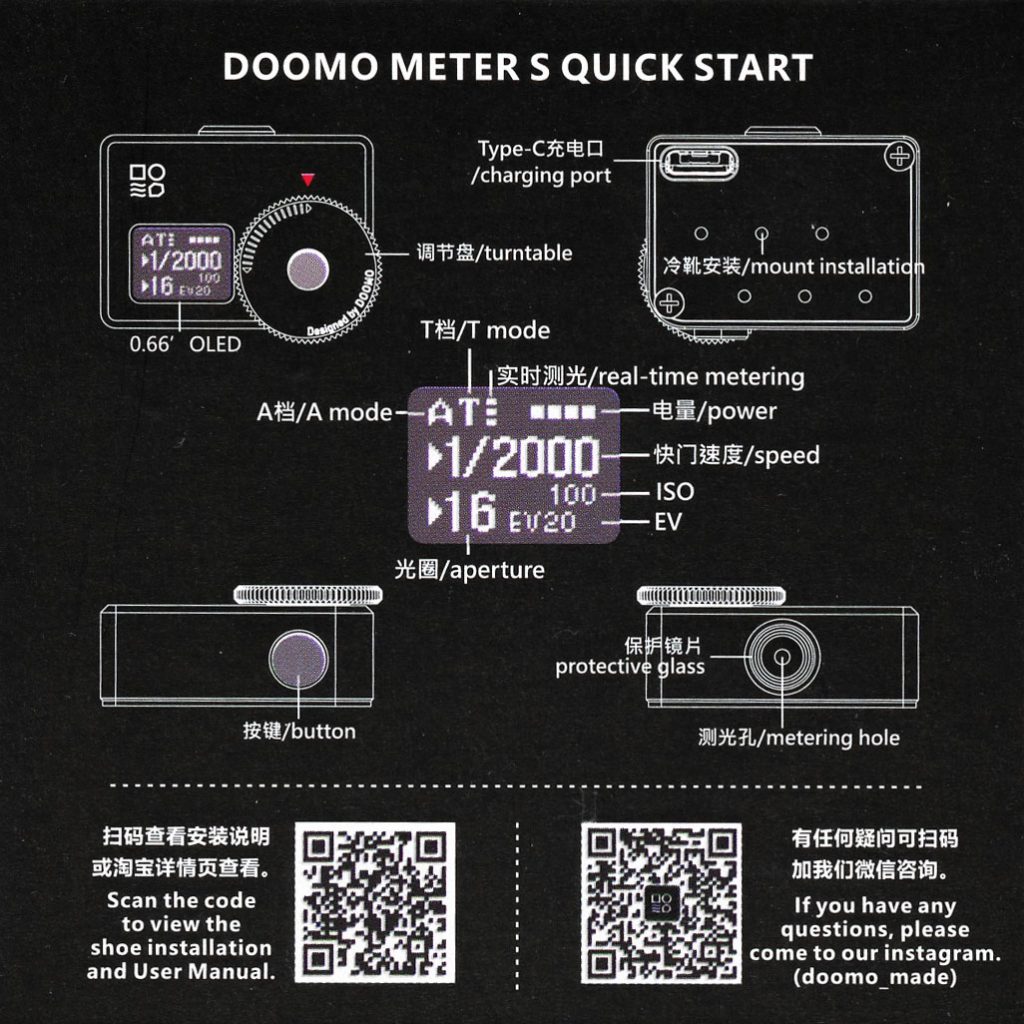





























Very thorough review, Mike. The limitations of this device suggest that, for critical work (like color transparencies), a recalibrated Pentax Spotmeter or similar unit with a narrow acceptance angle and CLA’d electronics is still a better way to go.
Yeah, this definitely isn’t for pro work as the margin of error is too much for critical work, but for under $100, I feel very comfortable recommended it for casual users who use color negative or black and white films. Plus, it looks really nice sitting on top of most cameras! 🙂
Thanks Mike.
I really enjoyed the great review and if I used anything beside Sunny 16 and my iPhone meter app, I would probably get it.
The odd f/stops made me check out my two early Leica Elmar 50mm f/3.5 collapsible lenses. They don’t have the odd f/6.7 and f/19 listed for the meter but the do have instead, f/6.3 and f/18.
Mike, I usually bring along a digital camera or phone with a light meter app to back up readings on the film cameras, but I had been looking for something affordable like this for a while, and surprisingly, having it look just like it belongs on these vintage cameras was a major requirement. Thanks for finding and reviewing this.
Glad it helped you make your decision. The DOOMO Meter S is hardly the perfect solution, but for the price, it is a very good one, and as you noticed, it looks great on a large number of cameras!
Great review! I’ve been waiting for someone to review this model. I am somewhat of a meter junkie, having a couple Leica shoe mount meters, the Reveni, the VCII, and a couple Sekonic hand-held (no spot meter, though). I have usually defaulted to the Sekonic L308S due to it’s readout and small and light form factor. But this one looks perfect, with the one wheel. I also think I saw that Doomo sells a reasonably-priced double shoe mount accessory, so you can use the meter and still mount an accessory viewfinder (like the old Voigtlander shoe mount that has now become ridiculously priced on the used market). This is another big plus for a camera like the Canon IVSB or Barnack Leicas. Seriously considering this one now.
Another nice review, Mike – thank you. This little gadget could be a great boon for classic camera users – I am definitely checking them out. Here’s a quick suggestion on the slight discrepancy in readings you found between the DOOMO and your digital camera. I don’t own a DOOMO and haven’t done any tests myself, so I may be all wet here. I didn’t see if you mentioned which metering mode you used on your Fuji – spot, center weighted, pattern, etc., so it’s hard to determine the acceptance angle of the camera’s meter. The DOOMO has a stated acceptance angle of 30 degrees which is basically equivalent to the field of view of a 90mm lens (coincidently the same as the classic Leitz MR meter!). If you used a normal lens on the Fuji and had it set to multi pattern metering, the acceptance angle of the Fuji could have had an acceptance angle of closer to 47 degrees – perhaps enough to make the difference you observed in your tests; especially if something very bright or dark was included in field of view. You may also have pointed the DOOMO at an especially bright or dark spot as well. Having used Leitz MR and MC meters with 30 degree acceptance angles – I know it takes a little practice to get exposure right with these kinds of meters. Check out the Leitz MR meter manual at Mike Butkus’ site. https://www.cameramanuals.org/flashes_meters/leica_meter_mr.pdf. Cheers! Paul
These are indeed quite good, and reasonably priced.I bought two of the little ‘Voigtlanders’ years ago- and a couple of the extension brackets-and have watched the prices climb steadily towards unaffordable
Great write up! If you get the chance, take a peek at the Lumu Power. The lack of an incident function in the vcii and this unit is the glaring weakness. If you want to get all the abilities in a tiny package (smaller than this little fella), exposure incident, reflected, illuminometry, flash, cumulative flash, color temp, all in one. There’s a newer version of the Lumu but it already does all the things so the only addition for the new price is flash color temp. I love the capabilities but for handling, comfort and speed?… i still use a small handheld. For shoe mount compact, i also like the Sekonic Twinmate L208; not quite as small but so much more useful.
Thanks for the recommendation. That is not one I’ve heard of before, but I just looked it up, and holy cow, that’s a bit out of my price range! I am pretty happy with the DOOMO, and if I were to get another, I might check out one of the KEKS meters as I like that it’s LCD screen faces rearward.